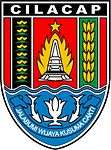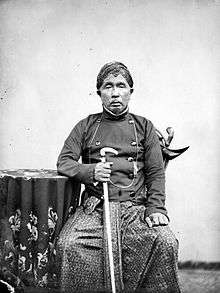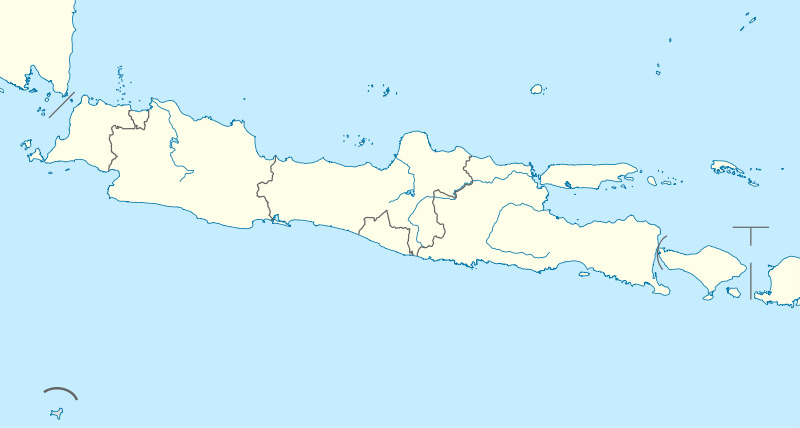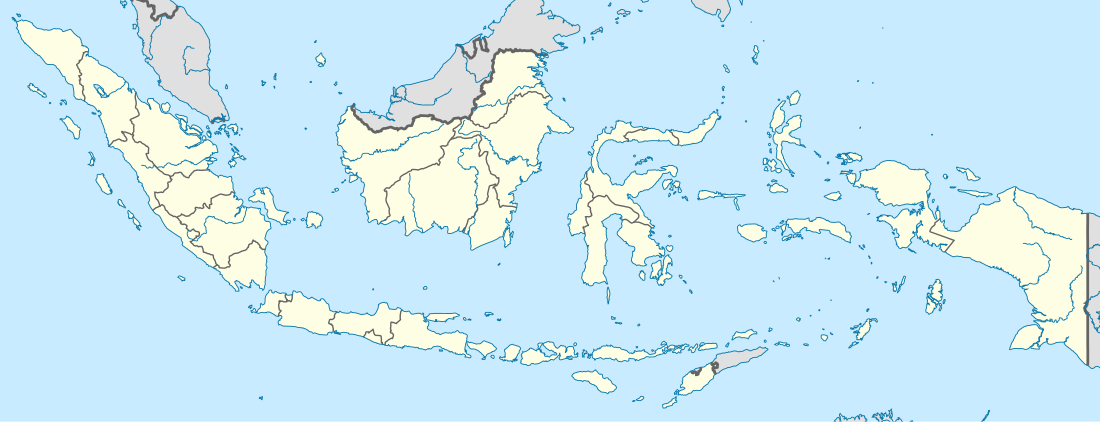Cilacap Regency
Cilacap Regency (Javanese: ꦏꦨꦸꦥꦠꦺꦤ꧀ꦕꦶꦭꦕꦥ꧀, also spelt: Chilachap, old spelling: Tjilatjap, Sundanese: ᮎᮤᮜᮎᮕ᮪) is a regency (Indonesian: kabupaten) in the southwestern part of Central Java province in Indonesia. Its capital is the town of Cilacap.
Cilacap Regency Kabupaten Cilacap | |
|---|---|
| Other transcription(s) | |
| • Javanese | ꦏꦨꦸꦥꦠꦺꦤ꧀ꦕꦶꦭꦕꦥ꧀ |
 Seal | |
 Location within Central Java | |
| Coordinates: 7°44′S 109°0′E | |
| Country | |
| Region | Java |
| Province | Central Java |
| Settled | April 20, 1205 |
| Capital | Cilacap |
| Government | |
| • Regent | Tatto Suwarto Pamuji |
| • Vice Regent | Akhmad Edi Susanto |
| Area | |
| • Total | 2,124.47 km2 (820.26 sq mi) |
| Population (2014) | |
| • Total | 1,662,248 |
| • Density | 780/km2 (2,000/sq mi) |
| Time zone | UTC+7 (IWST) |
| Area code | (+62) 280/282 |
| Website | cilacapkab |

Cilacap Regency covers an area of 2,124.47 km2, and it had a population of 1,642,107 at the 2010 Census;[1] the latest estimate (as of January 2014) is 1,662,248. The language used in Cilacap is the Javanese language, but most people can speak Indonesian. The dialect used is Banyumasan.
There are schools of all levels in Cilacap and several higher-learning institutions, but no university. There are several academies such as Akademi Maritim Nusantara (National Maritime Academy). A polytechnic, called Politeknik Cilacap, was established in 2008 and offers education in Engineering, Electronics and Informatics.
Administrative Districts
Cilacap Regency comprises twenty-four districts (kecamatan), tabulated below with their populations at the 2010 Census:[2]
|
|
|
Cilacap Town
The town of Cilacap is also a sea port on the southern coast of the island of Java. The port is one of only a few that exist on the southern coast that can service shipping of reasonable tonnage. The nearest safe anchorage east is Pacitan. The city's harbor is protected by Nusakambangan, an island best known as the site of several high-security correctional facilities although there are also hopes that the island can be developed as a tourist hub.[3] Nusakambangan sheltered Cilacap from the worst of the 2004 tsunami. Nevertheless, the disaster took 147 lives, devastated beaches, damaged 435 fishing boats and inflicted material losses amounting to about Rp 86 billion (around $9 million).
During World War II Cilacap was an important departure point for people fleeing the Japanese invasion, especially Dutch colonists. Many left the Dutch East Indies by boat or seaplane, the majority heading for Broome in Western Australia.
The port is a hub for national or international trade. The town's Tunggul Wulung Airport provides scheduled airline services to Jakarta and Semarang.
Cilacap is the site of many industrial plants, a geothermal power plant, a cement plant (Holcim Indonesia), and one of Pertamina (Indonesia's national petroleum company) processing units in Indonesia. The site has the largest production capacity, producing the most diverse kinds of products among other Pertamina units.
The town of Cilacap offers several tourist attractions highlighting Banyumasan culture. The town has a number of beaches, two of the most popular being Teluk Penyu (close to the center of town), but these are somewhat fouled from leakage of the shipping vessels docked adjacent to this and Widara Payung. Nearby the Teluk Penyu beach is also an ancient Dutch fortress called Benteng Pendem. This fortress was built in stages during 1861-1879 by the Dutch East Indies Army.
Segara Anakan
In early 2012 Segara Anakan Bay area is only 600 hectares from 700 hectares in 2005 after dredging. Heavy sedimentation from Citanduy River which is located in border of Ciamis Regency and Cilacap Regency caused it. To overcome the sedimentation in Segara Anakan Bay, Ciamis Regency has agreed, if a new canal from Citanduy River pass their area and exit in Nusawiru near Pangandaran Beach.[4]
Tourism gallery
 Cimandaway waterfall at district Dayeuhluhur, at Cikawalon River West Cilacap.
Cimandaway waterfall at district Dayeuhluhur, at Cikawalon River West Cilacap.
References
- Biro Pusat Statistik, Jakarta, 2011.
- Biro Pusat Statistik, Jakarta, 2011.
- Agus Maryono, 'Nusakambangan "a future tourist hub"', The Jakarta Post, 13 March 2012.
- "Citanduy akan Disodet untuk Pulihkan Segara Anakan". March 3, 2012. Archived from the original on July 30, 2017. Retrieved March 3, 2012.


